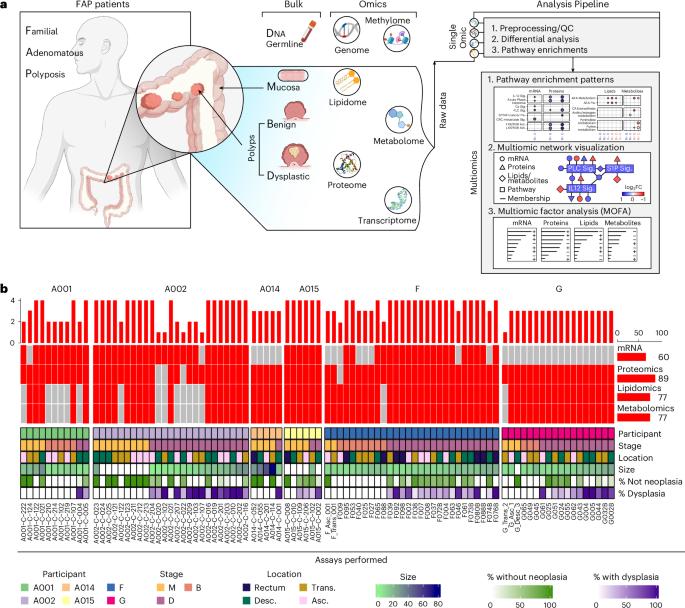Multiomic analysis of familial adenomatous polyposis reveals molecular pathways associated with early tumorigenesis
IF 23.5
1区 医学
Q1 ONCOLOGY
引用次数: 0
Abstract
Familial adenomatous polyposis (FAP) is a genetic disease causing hundreds of premalignant polyps in affected persons and is an ideal model to study transitions of early precancer states to colorectal cancer (CRC). We performed deep multiomic profiling of 93 samples, including normal mucosa, benign polyps and dysplastic polyps, from six persons with FAP. Transcriptomic, proteomic, metabolomic and lipidomic analyses revealed a dynamic choreography of thousands of molecular and cellular events that occur during precancerous transitions toward cancer formation. These involve processes such as cell proliferation, immune response, metabolic alterations (including amino acids and lipids), hormones and extracellular matrix proteins. Interestingly, activation of the arachidonic acid pathway was found to occur early in hyperplasia; this pathway is targeted by aspirin and other nonsteroidal anti-inflammatory drugs, a preventative treatment under investigation in persons with FAP. Overall, our results reveal key genomic, cellular and molecular events during the earliest steps in CRC formation and potential mechanisms of pharmaceutical prophylaxis. Snyder and colleagues present a comprehensive multiomic atlas of normal mucosal, benign polyps and dysplastic polyps from six persons with familial adenomatous polyposis, comprising transcriptomic, proteomic, metabolomic and lipidomic datasets.

家族性腺瘤性息肉病的多组学分析揭示了与早期肿瘤发生相关的分子通路。
家族性腺瘤性息肉病(FAP)是一种遗传疾病,会导致患者出现数百个恶性前息肉,是研究早期癌前状态向结直肠癌(CRC)转变的理想模型。我们对六名 FAP 患者的 93 份样本(包括正常粘膜、良性息肉和发育不良息肉)进行了深度多组学分析。转录组、蛋白质组、代谢组和脂质组分析揭示了癌前病变向癌症形成过渡期间发生的数以千计的分子和细胞事件的动态编排。这些事件涉及细胞增殖、免疫反应、代谢改变(包括氨基酸和脂质)、激素和细胞外基质蛋白等过程。有趣的是,研究发现花生四烯酸通路的激活发生在增生的早期;阿司匹林和其他非甾体抗炎药物针对的就是这一通路,FAP 患者正在对这一预防性治疗方法进行研究。总之,我们的研究结果揭示了 CRC 最早期形成过程中的关键基因组、细胞和分子事件,以及药物预防的潜在机制。
本文章由计算机程序翻译,如有差异,请以英文原文为准。
求助全文
约1分钟内获得全文
求助全文
来源期刊

Nature cancer
Medicine-Oncology
CiteScore
31.10
自引率
1.80%
发文量
129
期刊介绍:
Cancer is a devastating disease responsible for millions of deaths worldwide. However, many of these deaths could be prevented with improved prevention and treatment strategies. To achieve this, it is crucial to focus on accurate diagnosis, effective treatment methods, and understanding the socioeconomic factors that influence cancer rates.
Nature Cancer aims to serve as a unique platform for sharing the latest advancements in cancer research across various scientific fields, encompassing life sciences, physical sciences, applied sciences, and social sciences. The journal is particularly interested in fundamental research that enhances our understanding of tumor development and progression, as well as research that translates this knowledge into clinical applications through innovative diagnostic and therapeutic approaches. Additionally, Nature Cancer welcomes clinical studies that inform cancer diagnosis, treatment, and prevention, along with contributions exploring the societal impact of cancer on a global scale.
In addition to publishing original research, Nature Cancer will feature Comments, Reviews, News & Views, Features, and Correspondence that hold significant value for the diverse field of cancer research.
 求助内容:
求助内容: 应助结果提醒方式:
应助结果提醒方式:


